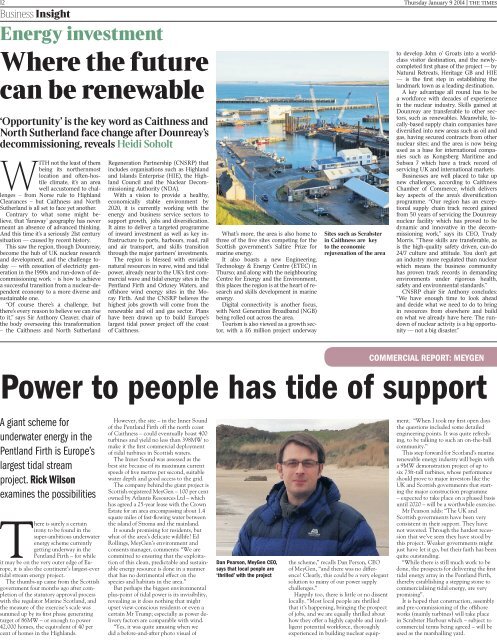Business Insight
The Highlands are a place of opportunity, the best place in the world to live and work, says Drew Hendry, leader of Highland Council. In this issue we look at the investment and vision creating this opportunity across the region. We start our journey in Inverness and at Inverness Campus, one of the largest projects that Highlands and Islands Enterprise (HIE) has embarked upon and one that is being hailed as a project of national importance. Brendan Dick, head of BT Scotland, discusses next generation broadband (NGB), its complexities and how it will benefit the people and businesses of the Highlands and Islands. We also go north to Caithness and Sutherland and discover why the run-down of nuclear activity is creating major opportunities for the area.
The Highlands are a place
of opportunity, the best
place in the world to live
and work, says Drew
Hendry, leader of Highland
Council. In this issue we
look at the investment and
vision creating this opportunity
across the region.
We start our journey in
Inverness and at Inverness
Campus, one of the largest
projects that Highlands and
Islands Enterprise (HIE)
has embarked upon and
one that is being hailed as
a project of national importance.
Brendan Dick, head of BT
Scotland, discusses next
generation broadband
(NGB), its complexities
and how it will benefit the
people and businesses of
the Highlands and Islands.
We also go north to
Caithness and Sutherland
and discover why the
run-down of nuclear
activity is creating major
opportunities for the area.
You also want an ePaper? Increase the reach of your titles
YUMPU automatically turns print PDFs into web optimized ePapers that Google loves.
12<br />
<strong>Business</strong> <strong>Insight</strong><br />
Energy investment<br />
Where the future<br />
can be renewable<br />
‘Opportunity’ is the key word as Caithness and<br />
North Sutherland face change after Dounreay’s<br />
decommissioning, reveals Heidi Soholt<br />
ITH not the least of them<br />
being its northernmost<br />
location and often-hostile<br />
climate, it’s an area<br />
well accustomed to challenges<br />
– from Norse rule to Highland<br />
Clearances – but Caithness and North<br />
Sutherland is all set to face yet another.<br />
Contrary to what some might believe,<br />
that ‘faraway’ geography has never<br />
meant an absence of advanced thinking.<br />
And this time it’s a seriously 21st century<br />
situation — caused by recent history.<br />
This saw the region, though Dounreay,<br />
become the hub of UK nuclear research<br />
and development, and the challenge today<br />
— with cessation of electricity generation<br />
in the 1990s and run-down of decommissioning<br />
work – is how to achieve<br />
a successful transition from a nuclear-dependent<br />
economy to a more diverse and<br />
sustainable one.<br />
“Of course there’s a challenge, but<br />
there’s every reason to believe we can rise<br />
to it,” says Sir Anthony Cleaver, chair of<br />
the body overseeing this transformation<br />
– the Caithness and North Sutherland<br />
Regeneration Partnership (CNSRP) that<br />
includes organisations such as Highland<br />
and Islands Enterprise (HIE), the Highland<br />
Council and the Nuclear Decommissioning<br />
Authority (NDA).<br />
With a vision to provide a healthy,<br />
economically stable environment by<br />
2020, it is currently working with the<br />
energy and business service sectors to<br />
support growth, jobs and diversification.<br />
It aims to deliver a targeted programme<br />
of inward investment as well as key infrastructure<br />
to ports, harbours, road, rail<br />
and air transport, and skills transition<br />
through the major partners’ investments.<br />
The region is blessed with enviable<br />
natural resources in wave, wind and tidal<br />
power, already near to the UK’s first commercial<br />
wave and tidal energy sites in the<br />
Pentland Firth and Orkney Waters, and<br />
offshore wind energy sites in the Moray<br />
Firth. And the CNSRP believes the<br />
highest jobs growth will come from the<br />
renewable and oil and gas sector. Plans<br />
have been drawn up to build Europe’s<br />
largest tidal power project off the coast<br />
of Caithness.<br />
What’s more, the area is also home to<br />
three of the five sites competing for the<br />
Scottish government’s Saltire Prize for<br />
marine energy.<br />
It also boasts a new Engineering,<br />
Technology & Energy Centre (ETEC) in<br />
Thurso; and along with the neighbouring<br />
Centre for Energy and the Environment,<br />
this places the region is at the heart of research<br />
and skills development in marine<br />
energy.<br />
Digital connectivity is another focus,<br />
with Next Generation Broadband (NGB)<br />
being rolled out across the area.<br />
Tourism is also viewed as a growth sector,<br />
with a £6 million project underway<br />
Sites such as Scrabster<br />
in Caithness are key<br />
to the economic<br />
rejuvenation of the area<br />
Thursday January 9 2014 | the times<br />
to develop John o’ Groats into a worldclass<br />
visitor destination, and the newlycompleted<br />
first phase of the project — by<br />
Natural Retreats, Heritage GB and HIE<br />
— is the first step in establishing the<br />
landmark town as a leading destination.<br />
A key advantage all round has to be<br />
a workforce with decades of experience<br />
in the nuclear industry. Skills gained at<br />
Dounreay are transferable to other sectors,<br />
such as renewables. Meanwhile, locally-based<br />
supply chain companies have<br />
diversified into new areas such as oil and<br />
gas, having secured contracts from other<br />
nuclear sites; and the area is now being<br />
used as a base for international companies<br />
such as Kongsberg Maritime and<br />
Subsea 7 which have a track record of<br />
servicing UK and international markets.<br />
<strong>Business</strong>es are well placed to take up<br />
new challenges, according to Caithness<br />
Chamber of Commerce, which delivers<br />
key aspects of the area’s diversification<br />
programme. “Our region has an exceptional<br />
supply chain track record gained<br />
from 50 years of servicing the Dounreay<br />
nuclear facility which has proved to be<br />
dynamic and innovative in the decommissioning<br />
work,” says its CEO, Trudy<br />
Morris. “These skills are transferable, as<br />
is the high-quality safety driven, can-do<br />
24/7 culture and attitude. You don’t get<br />
an industry more regulated than nuclear<br />
which means the business community<br />
has proven track records in demanding<br />
environments under rigorous health,<br />
safety and environmental standards.”<br />
CNSRP chair Sir Anthony concludes:<br />
“We have enough time to look ahead<br />
and decide what we need to do to bring<br />
in resources from elsewhere and build<br />
on what we already have here. The rundown<br />
of nuclear activity is a big opportunity<br />
— not a big disaster.”<br />
COMMERCIAL REPORT: MEYGEN<br />
Power to people has tide of support<br />
A giant scheme for<br />
underwater energy in the<br />
Pentland Firth is Europe’s<br />
largest tidal stream<br />
project. Rick Wilson<br />
examines the possibilities<br />
here is surely a certain<br />
irony to be found in the<br />
super-ambitious underwater<br />
energy scheme currently<br />
getting underway in the<br />
Pentland Firth – for while<br />
it may be on the very outer edge of Europe,<br />
it is also the continent’s largest-ever<br />
tidal stream energy project.<br />
The thumbs-up came from the Scottish<br />
government four months ago after completion<br />
of the statutory approval process<br />
with the regulator Marine Scotland, and<br />
the measure of the exercise’s scale was<br />
summed up by its first phase generating<br />
target of 86MW – or enough to power<br />
42,000 homes, the equivalent of 40 per<br />
cent of homes in the Highlands.<br />
However, the site – in the Inner Sound<br />
of the Pentland Firth off the north coast<br />
of Caithness – could eventually boast 400<br />
turbines and yield no less than 398MW to<br />
make it the first commercial deployment<br />
of tidal turbines in Scottish waters.<br />
The Inner Sound was assessed as the<br />
best site because of its maximum current<br />
speeds of five metres per second, suitable<br />
water depth and good access to the grid.<br />
The company behind the giant project is<br />
Scottish-registered MeyGen – 100 per cent<br />
owned by Atlantis Resources Ltd – which<br />
has agreed a 25-year lease with the Crown<br />
Estate for an area encompassing about 1.4<br />
square miles of fast-flowing water between<br />
the island of Stroma and the mainland.<br />
It sounds promising for residents, but<br />
what of the area’s delicate wildlife? Ed<br />
Rollings, MeyGen’s environment and<br />
consents manager, comments: “We are<br />
committed to ensuring that the exploitation<br />
of this clean, predictable and sustainable<br />
energy resource is done in a manner<br />
that has no detrimental effect on the<br />
species and habitats in the area.”<br />
But perhaps the biggest environmental<br />
plus-point of tidal power is its invisibility,<br />
revealing as it does nothing that might<br />
upset view-conscious residents or even a<br />
certain Mr Trump; especially as power delivery<br />
factors are comparable with wind.<br />
“Yes, it was quite amusing when we<br />
did a before-and-after photo visual of<br />
Dan Pearson, MeyGen CEO,<br />
says that local people are<br />
‘thrilled’ with the project<br />
the scheme,” recalls Dan Person, CEO<br />
of MeyGen, “and there was no difference!<br />
Clearly, this could be a very elegant<br />
solution to many of our power supply<br />
challenges.”<br />
Happily too, there is little or no dissent<br />
locally. “Most local people are thrilled<br />
that it’s happening, bringing the prospect<br />
of jobs, and we are equally thrilled about<br />
how they offer a highly capable and intelligent<br />
potential workforce, thoroughly<br />
experienced in building nuclear equipment.<br />
“When I took my first open days<br />
the questions included some detailed<br />
engineering points. It was quite refreshing,<br />
to be talking to such an on-the-ball<br />
community.”<br />
This step forward for Scotland’s marine<br />
renewable energy industry will begin with<br />
a 9MW demonstration project of up to<br />
six 73ft-tall turbines, whose performance<br />
should prove to major investors like the<br />
UK and Scottish governments that starting<br />
the major construction programme<br />
– expected to take place on a phased basis<br />
until 2020 – will be a worthwhile exercise.<br />
Mr Pearson adds: “The UK and<br />
Scottish governments have been very<br />
consistent in their support. They have<br />
not wavered. Through the hardest recession<br />
that we’ve seen they have stood by<br />
this project. Weaker governments might<br />
just have let it go, but their faith has been<br />
quite outstanding.<br />
“While there is still much work to be<br />
done, the prospects for delivering the first<br />
tidal energy array in the Pentland Firth,<br />
thereby establishing a stepping stone to<br />
commercialising tidal energy, are very<br />
promising”.<br />
It is hoped that construction, assembly<br />
and pre-commissioning of the offshore<br />
works (mainly turbines) will take place<br />
in Scrabster Harbour which – subject to<br />
commercial terms being agreed – will be<br />
used as the marshalling yard.

















